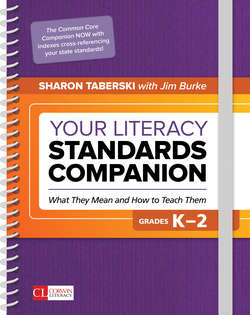Читать книгу Your Literacy Standards Companion, Grades K-2 - Jim Burke - Страница 57
На сайте Литреса книга снята с продажи.
Grades K–2 Common Core Reading Standard 4: Academic Vocabulary: Key Words and Phrases
ОглавлениеAlliteration: Repetition of the initial consonant sound in words that are close to one another (e.g., “wonderful wacky words”).
Figurative meanings: Figures of speech (or figurative language) are often-colorful ways of saying something that help create a picture in the mind of the reader. For K–2 students the most common figures of speech are metaphor, simile, and personification. A metaphor compares two things that are not typically associated with each other (e.g., “That room is an oven”). A simile typically uses the word like or as when making a comparison (e.g., “A blue whale’s skin is as slippery as a bar of soap”). Personification involves attributing human characteristics to something that is nonhuman (e.g., “The wind howled”).
Interpret: This is best understood as a way of explaining what an author wrote using more accessible, familiar language for those who lack experience with or knowledge of the subject or type of text.
Technical meaning: In general this term relates to words with specialized meanings that are specific to a topic or subject being investigated. For K–2 students we can narrow this down to mean domain-specific words that typically occur in texts related to a specific content area, such as rocks and minerals (igneous) or weather (cumulus).
Tone: When thinking of tone, think about tone of voice. The formal tone of the U.S. Constitution matches the work’s importance and subject; the informal tone of a literary text signals the relationship between the individuals and reveals the character of the speaker.
